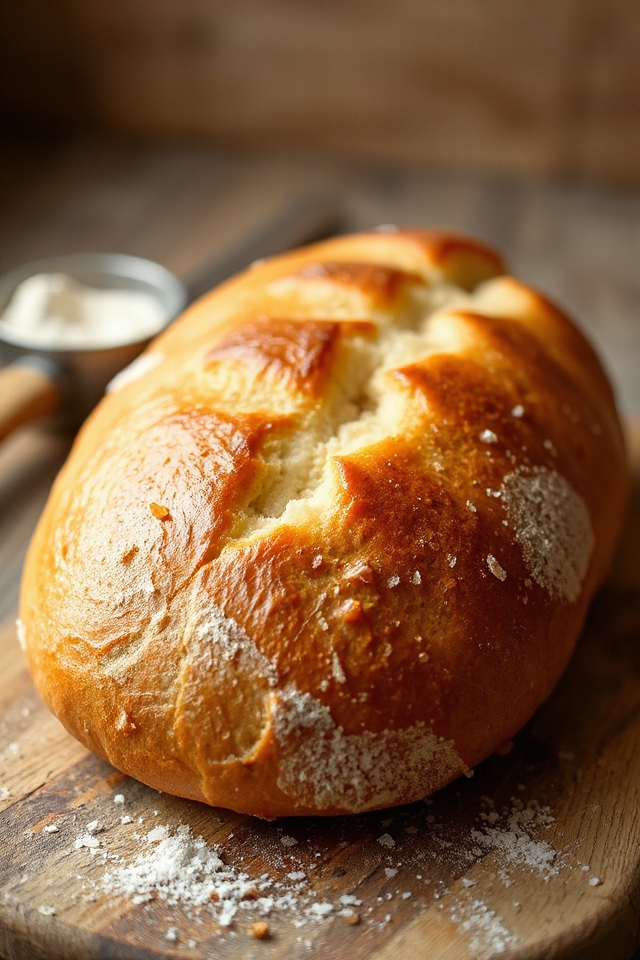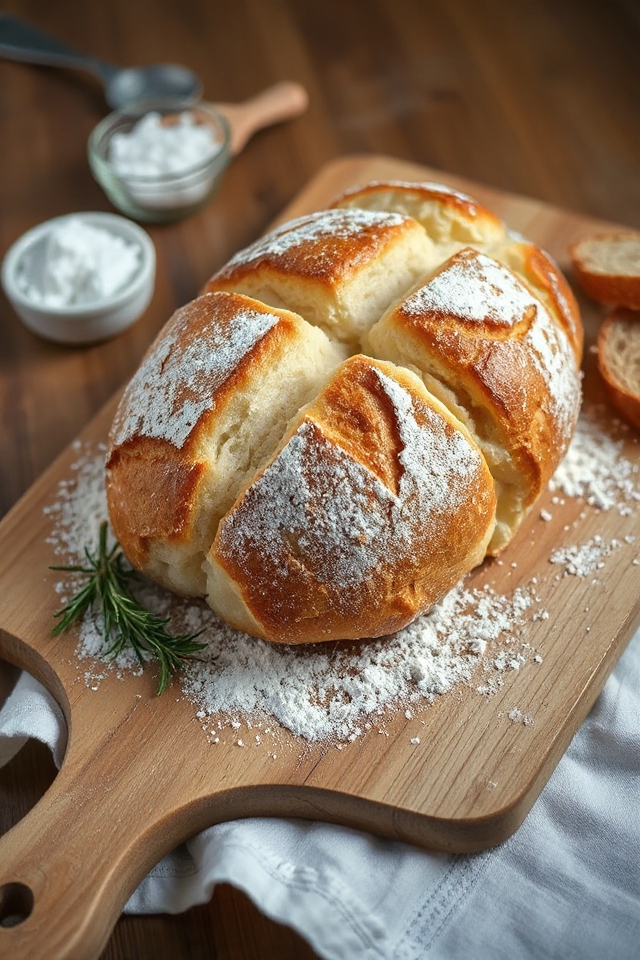Why You’ll Love This French Bread Recipe
You’ll love this French bread recipe because it captures the essence of traditional baking with a delightful crunch and soft, airy interior.
Every time I pull a fresh loaf from the oven, the aroma fills my kitchen, inviting everyone to gather around. The process is surprisingly simple, allowing me to connect with the art of baking.
I enjoy the satisfaction of kneading the dough, feeling it transform under my hands. Plus, nothing beats the feeling of slicing into a warm loaf, spreading butter, and savoring that first bite.
Trust me, once you try it, you’ll be hooked on homemade French bread!
Ingredients of French Bread
To whip up a delightful loaf of French bread, you’ll need a few simple ingredients that combine to create that perfect crust and airy interior. The beauty of this recipe lies in its simplicity; with just a handful of pantry staples, you can bring the aroma of freshly baked bread into your home.
Imagine the smell wafting through your kitchen—it’s enough to make anyone’s mouth water. So, let’s gather our ingredients and get ready to bake something magical.
Ingredients for French Bread:
- 4 cups all-purpose flour
- 1 ½ cups warm water (about 110°F)
- 2 teaspoons salt
- 2 teaspoons sugar
- 2 teaspoons active dry yeast
- Extra flour for dusting
When you’re picking out the ingredients, it’s worth noting that the quality of your flour can make a difference. I usually go for all-purpose flour because it balances perfectly between structure and softness.
And don’t skip on the yeast—fresh yeast, if you can find it, works wonders for that airy texture. Also, the warm water is essential; too hot, and you might kill the yeast, but too cool won’t activate it properly.
So, aim for that sweet spot of warmth, just like Goldilocks would. And while we’re on the topic, if you’re feeling adventurous, you can always experiment with adding a little bit of whole wheat flour for a heartier flavor.
Baking is all about exploring, right?
How to Make French Bread

To make your own delicious French bread, start by grabbing those 4 cups of all-purpose flour. In a large mixing bowl, combine the flour with 2 teaspoons of salt and 2 teaspoons of sugar. This combination will help to balance the flavors perfectly.
Now, here’s where the magic begins: in a separate bowl, warm up 1 ½ cups of water until it’s about 110°F. Not too hot—that would be a disaster for our yeast. You want it just warm enough to entice those tiny yeast soldiers into action. Sprinkle 2 teaspoons of active dry yeast into the warm water, give it a gentle stir, and let it sit for about 5 to 10 minutes. You’ll know it’s ready when it’s all frothy and bubbly. It’s like a mini science experiment, and it’s kind of exciting, isn’t it?
Once your yeast is all frothy, pour it into the flour mixture. Mix it together until it forms a shaggy dough. This is the part where you get to release your inner bread maker.
Turn the dough out onto a lightly floured surface and knead it for about 8 to 10 minutes. You’ll want to work that dough until it’s smooth and elastic, and hey, if your arms start to feel like jelly, that’s just a bonus workout.
After kneading, place the dough in a greased bowl, cover it with a damp cloth, and let it rise in a warm place for about an hour, or until it doubles in size. Now you can take a break, maybe catch up on a show or enjoy a snack. You deserve it.
Once the dough has risen, punch it down (yes, really, take out all that frustration) and turn it out onto the floured surface again. Shape it into a loaf or divide it into two smaller loaves, depending on how much bread you want to devour.
Place the shaped dough on a baking sheet lined with parchment paper, dust it with a little extra flour, and cover it again to rise for about 30 minutes. Preheat your oven to 425°F while you wait.
When the dough is puffy and ready, make a few diagonal slashes on top with a sharp knife. This isn’t just for looks; it helps the bread expand properly while baking.
Pop it in the oven for about 25 to 30 minutes, and soon you’ll be greeted with the glorious smell of freshly baked French bread wafting through your home. Just try not to eat the whole loaf in one sitting, though I won’t judge if you do. Enjoy!
French Bread Substitutions & Variations
After mastering the basics of making French bread, you might want to switch things up with some substitutions and variations.
For a nuttier flavor, try adding whole wheat flour or even spelt flour. If you’re in the mood for something savory, mix in herbs like rosemary or thyme.
You can also experiment with toppings—sprinkle sesame or poppy seeds on top before baking for added texture.
Feeling adventurous? Consider incorporating ingredients like olives or sun-dried tomatoes for a Mediterranean twist.
Each variation brings a unique flavor profile, keeping your French bread experience exciting and delicious!
What to Serve with French Bread
While enjoying freshly baked French bread, consider pairing it with a variety of delicious accompaniments that elevate your meal.
I love serving it with a rich, creamy butter or a flavorful olive oil for dipping. You can’t go wrong with a fresh herb-infused spread or a tangy tapenade.
If you’re feeling indulgent, try it alongside a savory cheese platter or a hearty soup. French bread also shines when paired with a classic bruschetta or a revitalizing salad.
Whatever you choose, these additions will complement the bread beautifully, making your dining experience even more delightful. Enjoy!
Additional Tips & Notes
Although baking French bread might seem intimidating at first, a few simple tips can make the process easier and more enjoyable.
First, always use high-quality flour; it really makes a difference. Don’t rush the rising time; patience is key for that perfect texture.
I like to create steam in the oven by placing a pan of hot water below the baking bread. This helps achieve a crispy crust.
Finally, let the bread cool completely before slicing; it’ll taste better!
